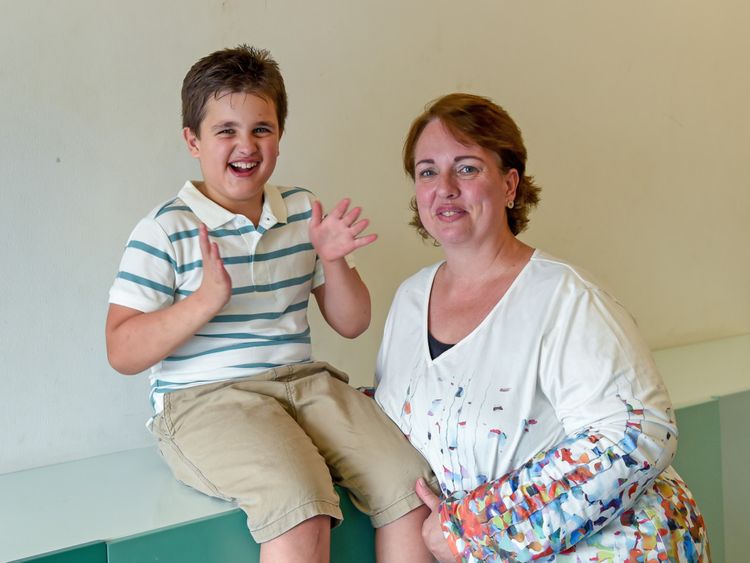Angelman syndrome is a complex condition that affects a person’s brain and nervous system. Kids with Angelman often have trouble talking, walking, and learning new things. But don’t let that fool you!
People with Angelman are usually really happy and smiley. They love to laugh and play. It’s like they bring sunshine wherever they go! While there’s no cure for Angelman, there are ways to help people with the condition live happy and full lives. With the right support, they can learn new skills and enjoy life to the fullest.
Angelman Syndrome: A Closer Look

What is Angelman syndrome?
Angelman syndrome is a complex condition that affects a person’s brain and nervous system.
Angelman syndrome is caused by a genetic mutation on chromosome 15. The name of this gene is UBE3A. Normally, people inherit one copy of the gene from each parent, and both copies become active in many areas in the body. Angelman syndrome occurs when only one copy of the gene is active in certain areas of the brain. While it can present challenges, it’s important to remember that every individual with Angelman is unique.
Common Characteristics
People with Angelman syndrome often share some common traits:
- Delayed development: They may reach milestones like sitting, crawling, or talking later than other children.
- Intellectual disability: This can affect learning and understanding.
- Speech challenges: Many individuals with Angelman have difficulty speaking.
- Movement problems: Balance and coordination can be affected.
- Seizures: These are common in people with Angelman syndrome.
- Happy demeanor: This is a hallmark of the condition. People with Angelman often have a cheerful and outgoing personality.
Life with Angelman Syndrome
Living with Angelman syndrome can be challenging, but it’s also filled with joy. With the right support, individuals can lead fulfilling lives. This might include:
- Therapy: Speech, physical, and occupational therapy can help improve skills.
- Education: Special education programs can provide tailored learning experiences.
- Medical care: Regular check-ups and medications can manage seizures and other health issues.
- Support groups: Connecting with other families can offer valuable advice and emotional support.
Challenges and Treatments for Angelman Syndrome
Living with Angelman syndrome can present unique challenges.
Common Challenges
- Seizures: Many individuals with Angelman experience seizures, which can be managed with medication but can be a significant challenge.
- Sleep disturbances: Irregular sleep patterns are common, often leading to daytime sleepiness and nighttime awakenings.
- Feeding difficulties: Some individuals may have trouble swallowing or chewing, making mealtimes challenging.
- Behavioral issues: Hyperactivity, attention difficulties, and impulsivity can be present.
- Communication challenges: Limited speech and expressive language can be frustrating for individuals and caregivers.
Treatment and Support
While there’s no cure for Angelman syndrome, various interventions can improve quality of life:
Medication: Anti-seizure medications are crucial for managing seizures.
- Anti-seizure medications: These are essential to control seizures, a common symptom of Angelman syndrome.
- Sleep aids: Medications can help regulate sleep patterns, which are often disrupted in individuals with Angelman syndrome.
- Growth hormone therapy: In some cases, growth hormone therapy can be beneficial for individuals with growth delays.
Therapeutic Interventions
- Speech therapy: This helps individuals develop communication skills, such as using sign language or augmentative and alternative communication (AAC) devices.
- Physical therapy: Focusing on balance, coordination, and gross motor skills.
- Occupational therapy: Assisting with daily living activities and fine motor skills.
- Behavioral therapy: Addressing challenges like hyperactivity and impulsivity.

Amelia’s Story
My name is Amelia Beatty, and this is my son Orion. As with all parents when their child is diagnosed with AS, my husband and I were devastated. I remember very clearly the geneticist giving us a long list of all the things that Orion would never be able to do. Our dreams for Orion were crushed. A friend connected me with another mom whose child also has AS, and she told me about FAST. “Angelman syndrome is treatable,” she said. “FAST is funding research to find a cure.” I dared to hope for a brighter future for Orion.
Support and Resources
- Support groups: Connecting with other families facing similar challenges can provide invaluable emotional support and practical advice.
- Early intervention: Early intervention services can help identify developmental delays and provide appropriate support.
- Educational support: Specialized education programs can create a learning environment tailored to the needs of individuals with Angelman syndrome.
- Assistive technology: Devices like communication aids, mobility equipment, and sensory tools can enhance independence.
Remember: Every individual with Angelman syndrome is unique, and treatment plans should be personalized. It’s essential to work closely with a team of healthcare professionals to develop a comprehensive care plan.
A multidisciplinary approach involving doctors, therapists, and educators is often the most effective way to address the challenges associated with this condition.
Support Organizations and Research for Angelman Syndrome
Support Organizations
Several organizations dedicated to supporting individuals with Angelman syndrome and their families exist. These groups offer valuable resources, information, and a sense of community.
- Foundation for Angelman Syndrome (FAS): A leading organization providing support, education, and funding for research.
- Angelman Syndrome Association (ASA): Offers support, resources, and advocacy for the Angelman community.
- National Angelman Syndrome Foundation (NASF): Provides information, support, and funds research into Angelman syndrome.
These organizations offer a range of services, including:
- Support groups
- Educational materials
- Advocacy efforts
- Research funding
Research Advancements
While there’s currently no cure for Angelman syndrome, ongoing research is bringing hope for the future. Scientists are actively exploring potential treatments and therapies. Some areas of focus include:
While there’s no cure for Angelman syndrome yet, scientists are working hard to change that.
Researchers are exploring different ways to help people with Angelman syndrome:
- Fixing the problem at its source: They’re trying to repair the faulty gene that causes Angelman syndrome. This is called gene therapy.
- Developing new medicines: Scientists are searching for drugs that can help manage the symptoms of Angelman syndrome, like seizures or sleep problems.
- Understanding the brain: By studying how Angelman syndrome affects the brain, researchers hope to find better ways to help people with the condition.
It’s exciting to see all the progress being made, and it gives families hope for the future. It’s important to stay informed about the latest research developments as new treatments and therapies may become available in the future.

How British mum discovered her son has Angelman Syndrome
Day to day Life with Angelman Syndrome
Living with Angelman syndrome can be a mixed bag. There are challenges, sure, but there’s also a whole lot of joy and love.
Keeping Things Steady:
People with Angelman syndrome often thrive on routine. Having a predictable schedule can help them feel safe and manage things like sleep and behavior. Sensory activities are also a big deal – music, water play, exploring different textures – these can be super calming and fun!
Finding Ways to Talk:
Communication can be tricky, but with assistive devices like picture cards or sign language, individuals with Angelman syndrome can express their needs and wants.
Bumpy Roads:
Some challenges pop up, like sleep problems (which can be tough on everyone!), hyperactivity, and difficulty focusing.But with patience and understanding, these can be managed. There might also be feeding difficulties for some individuals.
Being There for Sunshine:
Supporting someone with Angelman syndrome is all about patience, understanding their strengths, and celebrating their wins, no matter how small they might seem.
Making a Sunshine Squad:
Creating a safe environment at home is key, and so is building a support network of friends and family. Connecting with other families facing similar challenges can be a huge help.
Angelman syndrome is a unique condition that affects each person differently. While there are challenges, it’s important to focus on the individual’s strengths and abilities. With love, support, and the right resources, people with Angelman syndrome can live happy and fulfilling lives. Remember, every person with Angelman is special and deserves to be celebrated.

